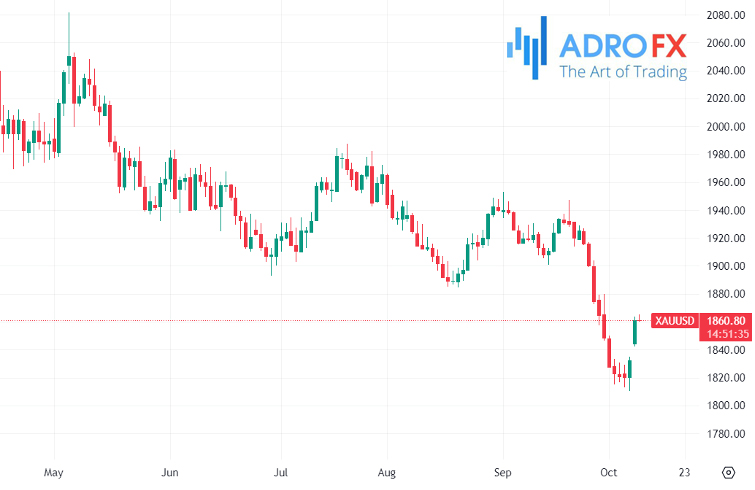Markets Navigate Geopolitical Tensions: S&P 500 Rises, Japanese Yen Surges, and Gold Rebounds | Daily Market Analysis

Key events:
- Eurozone - ECB President Lagarde Speaks
- USA - FOMC Member Bostic Speaks
- USA - FOMC Member Kashkari Speaks
On Monday, the S&P 500 managed to climb despite escalating geopolitical tensions in the wake of the Israel-Hamas conflict, which raised concerns about a broader Middle East war.
The S&P 500 saw a 0.6% increase, while the Dow Jones Industrial Average rose by 0.5%, equivalent to 162 points, and the Nasdaq registered a 0.4% uptick.

Investor focus shifted significantly due to the unexpected attack by Hamas on Israel and Israel's subsequent declaration of war. These developments temporarily tempered risk appetite.
This intensifying conflict occurred just as hopes were growing for a potential US-brokered deal that could lead to normalized relations between Saudi Arabia and Israel, potentially offering a path to resolving the long-standing Arab-Israeli conflict.
Chevron Corp (NYSE: CVX) experienced a more than 3% increase following an announcement that the Israeli government had ordered the shutdown of natural gas production at the Tamar platform in the Mediterranean due to safety concerns.

The surge in energy stocks was further fueled by concerns about potential disruptions in the oil-rich Middle East due to the mounting geopolitical tensions.
In response to these circumstances, defensive stocks made gains amid the escalating geopolitical landscape. Intel (NASDAQ: INTC) saw a slight dip in its stock price, although it managed to recover some losses. Concerns emerged about the impact of the conflict on the chipmaker's plans to construct a new chip-making facility in Israel.

Earlier this year, Intel had committed to investing around $25 billion in building a new chip manufacturing plant in Israel, with expectations of it becoming operational by 2027.
Tesla (NASDAQ: TSLA) experienced a marginal decrease of less than 1% in its stock price. This dip came as data from the China Passenger Car Association indicated a 10.9% decline in Tesla's sales in China for September compared to the same period the previous year, suggesting a potential waning of the electric vehicle maker's influence in the Chinese market.
Surprisingly, the Japanese Yen has emerged as a beneficiary of the escalating tensions in the Middle East, marking a reversal from the past 12 months when the US Dollar was the favored safe haven currency. This shift has become evident as USD/JPY faced a decline, particularly today, while the Dollar Index (DXY) struggled to maintain gains during the European and Asian trading sessions.

Last week, the Bank of Japan (BoJ) carried out a significant bond-buying operation to support the Japanese Yen, precisely as USD/JPY crossed the 150.00 threshold. In response, there was an initial drop of approximately 250 pips, followed by a rapid recovery. The BoJ had initially announced these extraordinary purchases on October 2, emphasizing its willingness to take responsive measures, including additional outright purchases of Japanese Government Bonds (JGBs).
Meanwhile, the Dollar Index appeared poised for a decline this week after forming a shooting star candle close near a key resistance level last Friday. However, the outbreak of the Israel-Palestine conflict over the weekend seemed to inject renewed strength into the US Dollar. Nevertheless, as the day unfolded, the DXY surrendered its gains amid significant geopolitical uncertainty and the anticipation of US Consumer Price Index (CPI) data later in the week.

In the wake of the Middle East conflict, the price of gold rebounded strongly from a seven-month low at the beginning of the week, reclaiming levels above US$1,860 per troy ounce. Gold's perceived safe haven status provided support, and it also benefited from the headwinds faced by a weaker US Dollar, with Treasury yields reversing their gains from the previous week.

Notably, the benchmark 10-year bond yield surged to 4.88% on Friday, marking the highest return for this low-risk asset since 2007. However, it has since retreated to below 4.65% this week following dovish remarks from Federal Reserve Vice Chair Philip Jefferson and Dallas Fed President Lorie Logan. Ironically, both central bankers cited the higher long-term Treasury yields as a reason for adopting a less hawkish stance in the future. This shift in sentiment has led the interest rate market to largely rule out another rate hike by the Fed and even anticipate a rate cut by the middle of the next year.









